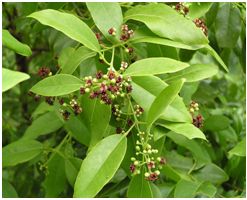
Botanical Name - Santalum album
Common Name - Indian Sandalwood, Chandan
Classification
Kingdom – Plantae
Class – Magnoliopsida
Order – Santalales
Family – Santalaceae
Genus – Santalum
Species – album
General characteristics of family Santalaceae
Santalaceae consists of 29 genera with ~400 species, out which 19 species are specific to Santalum genus.Plants mostly semi-parasites, flowers tetra or pentamerous 3-5 carpellate, ovary unilocular, single basal ovule with integument reduced to one or absent and the seed without a seed-coat.
Plant Description
Habit : Plants semiparastic herbs, shrubs or small trees, mostly semiparasites on branches of trees or on roots e.g., Santalum album L. (Swet chandan) is a root parasite, Thesium humifustum DC is a herbaceous root parasite. The Seedlings get themselves attached to the host by suckers.
Status : Vulnerable
Root : Tap-root, gives suckers or houstoria which penetrate into root or rhizome of host plants.
Stem : Erect, branched, herbaceous or woody, solid, cylindrical.
Leaf : Simple, entire, opposite, sometimes alternate, leathery, exstipulate, petiolate, foliaceous or reduced to scales.
Floral characters:
Inflorescence : Various types—racame, spike, head, dichasial sometimes flowers are axillary solitary.
Flower : All transitions from bisexual to unisexual, staminate or pistillate; dioecious plants with unisexual flowers (Osyris pyrularia, Comandra ulmbellata).
Perianth : 3 tepals (Osyris), pentamerous perianth, either sepaloid or petaloid, valvate aestivation.
Androecium : Stamens as many as perianth, opposite, epiphyllous, filaments short, anthers bithecous, basifixed, dehiscing vertically; a tuft of hairs present behind each filament.
Gynoecium : Carpels 3-5 (rarely 2) syncarpous, ovary inferior or semi-inferior, unilocular, ovules 1-5 usually 3, differentiate from placenta, basal placentation or only one fertile borne on the apical end of central placenta, and pendulous, ortho-to anatropous, ovule without integument.
Fruit : Achene or drupe.
Seed : Seeds without testa with fleshy endosperm, embryo straight.
Pollination : Entomophilous due to nectar secreting disc, often present.
Floral formula:
Medicinal uses
1. Antiseptic
Santalum album has antiseptic properties against bacteria and fungi.It is applicable to the skin in the form of massage to reduce mild inflammation in the skin caused by bacterial agents on superficial wounds, warts, cysts, or pimples.In traditional Asian medicine, it has been used since the beginning to combat urinary tract infections and mucus in the throat and chest.
2. Improves concentration and helps us relax
The aroma of sandalwood oil (Santalum album) has calming properties for the nervous system, so it helps to relax us in stressful situations.In fact, it is an important ingredient in aromatherapy, which uses different aromatic compounds to stimulate or depress our nervous system.
3. Natural aphrodisiac
Many times, it has been said that sandalwood oil has aphrodisiac properties. This is because it can be used as an oil when performing massages or with gels and lotions that contain this essential oil.Sandalwood is also an aphrodisiac that can help increase libido, especially for men, and provide energy. Sandalwood is excellent when added to massage oil or topical lotion.
4. Strengthens memory
Since one of the benefits of this tree is to offer a state of relaxation and calm in the face of anxiety, Santalum album works as a memory booster, so it is useful in aromatherapy before studying or when we need to concentrate to the maximum to perform an activity.